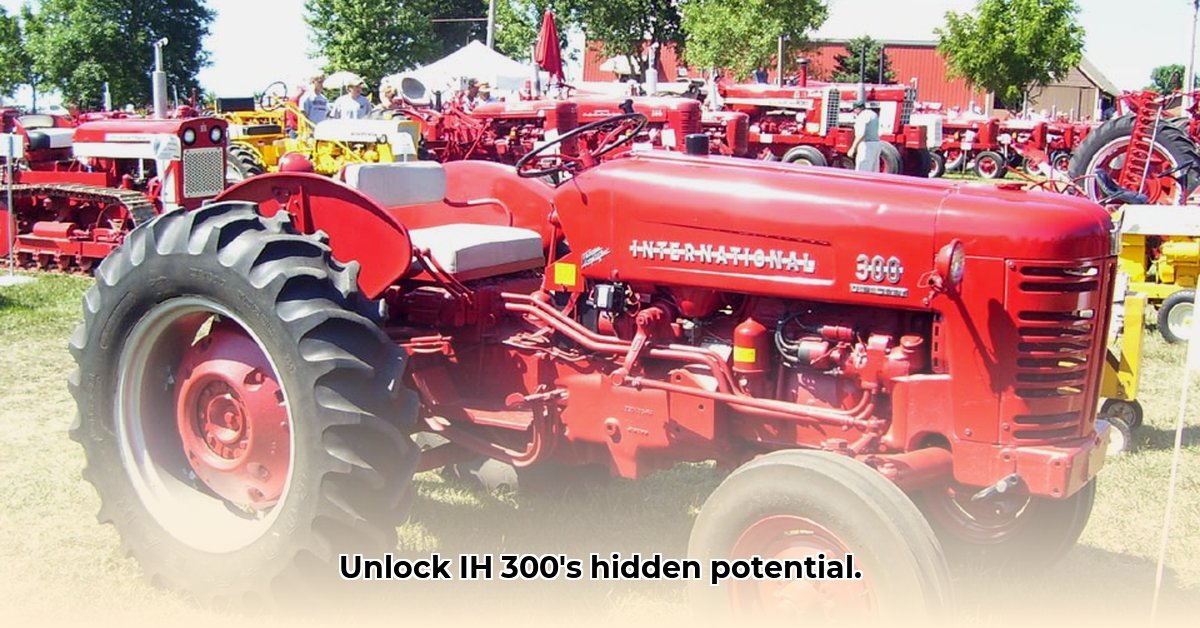
The International Harvester 300: A Timeless Classic
The International Harvester (IH) 300 utility tractor, produced between 1955 and 1958, represents a significant piece of agricultural history. More than 59,000 units were manufactured, solidifying its place as a workhorse on farms across America. But is owning one a worthwhile endeavor today? This comprehensive guide explores the IH 300, covering its history, various models, pricing, maintenance, and the crucial aspects of finding parts. We’ll help you determine if this classic machine is the right fit for your needs. For a comparison with modern tractors, check out new compact tractors.
Understanding the IH 300's Variants
The IH 300 wasn't a one-size-fits-all machine. International Harvester offered variations to cater to diverse farming requirements. Row-crop versions, often designated as Farmall 300s, were designed for working between rows of crops, while standard utility models provided more general-purpose functionality. Engine and transmission options further enhanced the 300's versatility, making it a popular choice for farmers needing a reliable, adaptable workhorse. This variety contributes significantly to the tractor's enduring appeal among collectors and enthusiasts. Have you ever considered the impact of this versatility on the tractor's long-term value?
Pricing and Market Value: What to Expect
The cost of an IH 300 varies significantly based on condition, hours of operation, and included accessories. Prices range from a few thousand dollars to over $6,500. A well-maintained, low-hour tractor in excellent condition will naturally command a higher price. Thorough research, comparing numerous listings, is essential to gauge fair market value. Remember, a detailed inspection is paramount before committing to a purchase. Do you believe the investment is worth the potential historical and sentimental value?
Maintenance and Parts: A Realistic Assessment
Maintaining a nearly 70-year-old tractor presents unique challenges. Sourcing original parts often necessitates searching salvage yards, online forums (such as Yesterday's Tractors1), and specialized parts suppliers. This requires mechanical aptitude and a willingness to invest time and effort in repairs. While the simpler mechanical design compared to modern tractors can be an advantage for those with the knowledge, the lack of readily available parts is a significant consideration for potential owners. How comfortable are you with the realities of vintage tractor maintenance?
Weighing the Pros and Cons: Is an IH 300 Right for You?
| Pros | Cons |
|---|---|
| Historical Significance & Collector's Item Value | High Maintenance & Repair Costs |
| Relatively Simple Mechanics | Parts Availability Can Be Challenging |
| Versatility | Requires Specialized Knowledge & Mechanical Skills |
| Potential for significant appreciation in value | Potential for Unexpected and Costly Repairs |
| Unique Character and Charm | Time investment in finding parts and performing repairs |
Before You Buy: A Critical Checklist
Before purchasing an IH 300, ask yourself these crucial questions:
- Purpose: Is this a working tractor or primarily a restoration project?
- Mechanical Skills: Are you comfortable with repairs and maintenance?
- Budget: Include purchase price, parts, tools, and potential repairs.
- Usage Plan: Will you use the tractor regularly, or will it be mostly stored?
Your Action Plan: A Step-by-Step Guide to Purchase
- Research: Thoroughly research market prices, comparing models and conditions.
- Inspection: Conduct a meticulous hands-on inspection, checking for wear and tear.
- Test Drive: Test all functions to identify any mechanical issues.
- Parts Availability: Inquire about parts availability before finalizing a purchase.
- Budgeting: Develop a detailed budget that accounts for all potential expenses.
Finding Affordable IH 300 Parts: A Strategic Approach
Locating affordable parts requires a multi-pronged strategy:
- Online Marketplaces: Explore eBay and similar platforms for potential deals.
- Specialty Suppliers: Utilize websites that specialize in classic tractor parts.
- Local Shops: Network with local tractor repair shops.
- Online Forums: Engage with online communities for IH 300 owners.
- Junkyards: Search salvage yards for potential parts.
Smart Strategies for Saving Money on Parts:
- Prioritize Repair over Replacement: Assess the cost-effectiveness of repair versus replacement.
- Buy Used Parts When Possible: Carefully inspect used parts for wear and tear.
- Negotiate Prices: Don't hesitate to negotiate, particularly for multiple parts.
- Compare Prices Aggressively: Always compare prices from multiple sources.
- Consider Rebuilding Parts: If you're mechanically inclined, rebuilding parts can save money.
Conclusion: Embark on Your IH 300 Journey
Acquiring an IH 300 is a rewarding but challenging endeavor. Careful planning, thorough research, and a realistic assessment of your skills and budget are crucial. However, owning a piece of agricultural history – a tractor known for its durability and charm – can be a deeply satisfying experience. Remember, preparation is key to success. Good luck, and happy hunting!